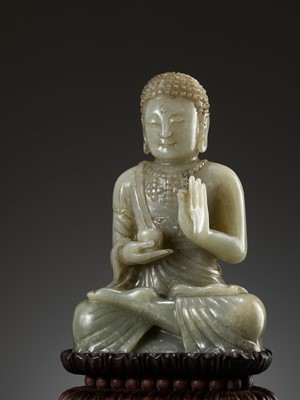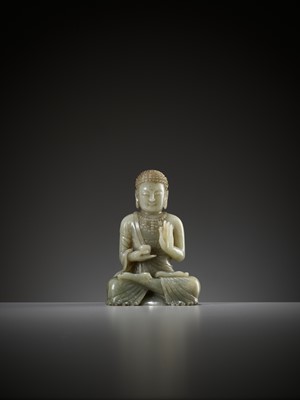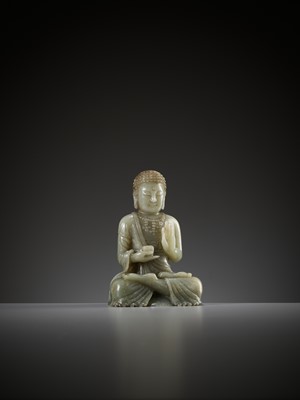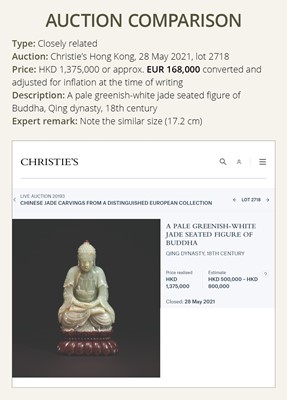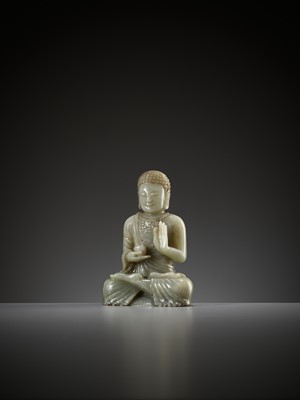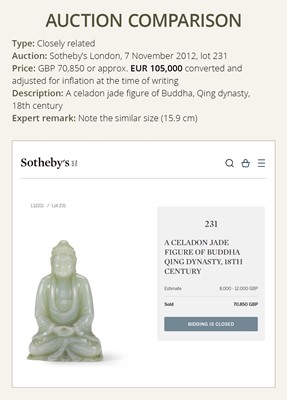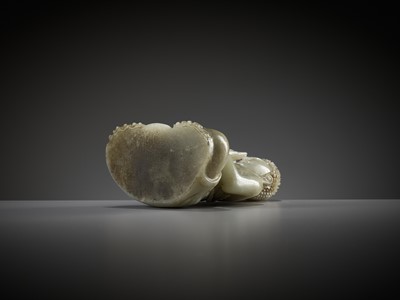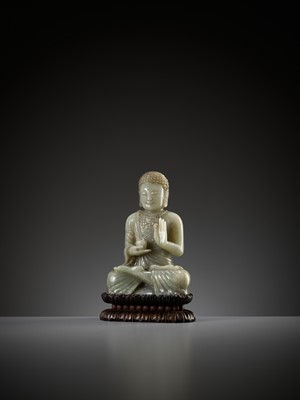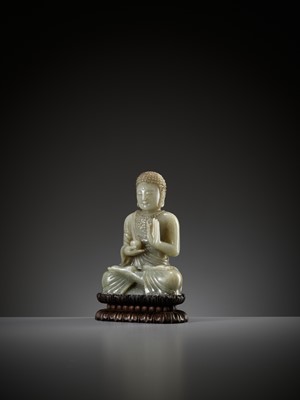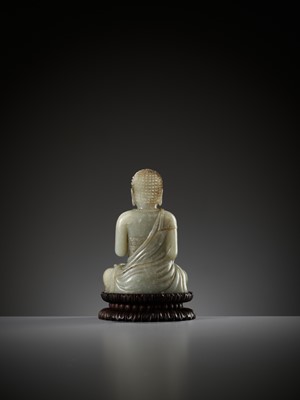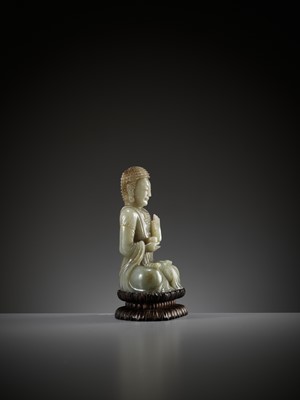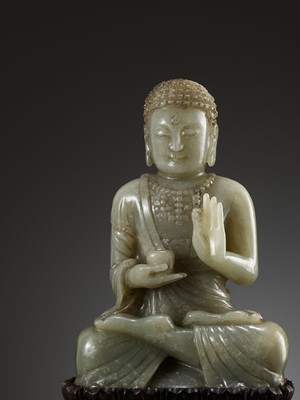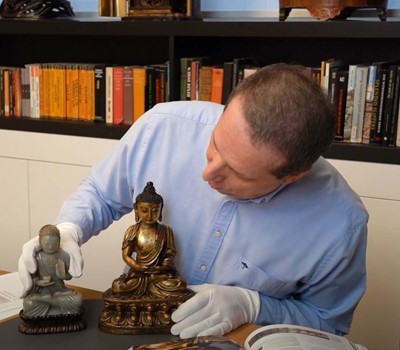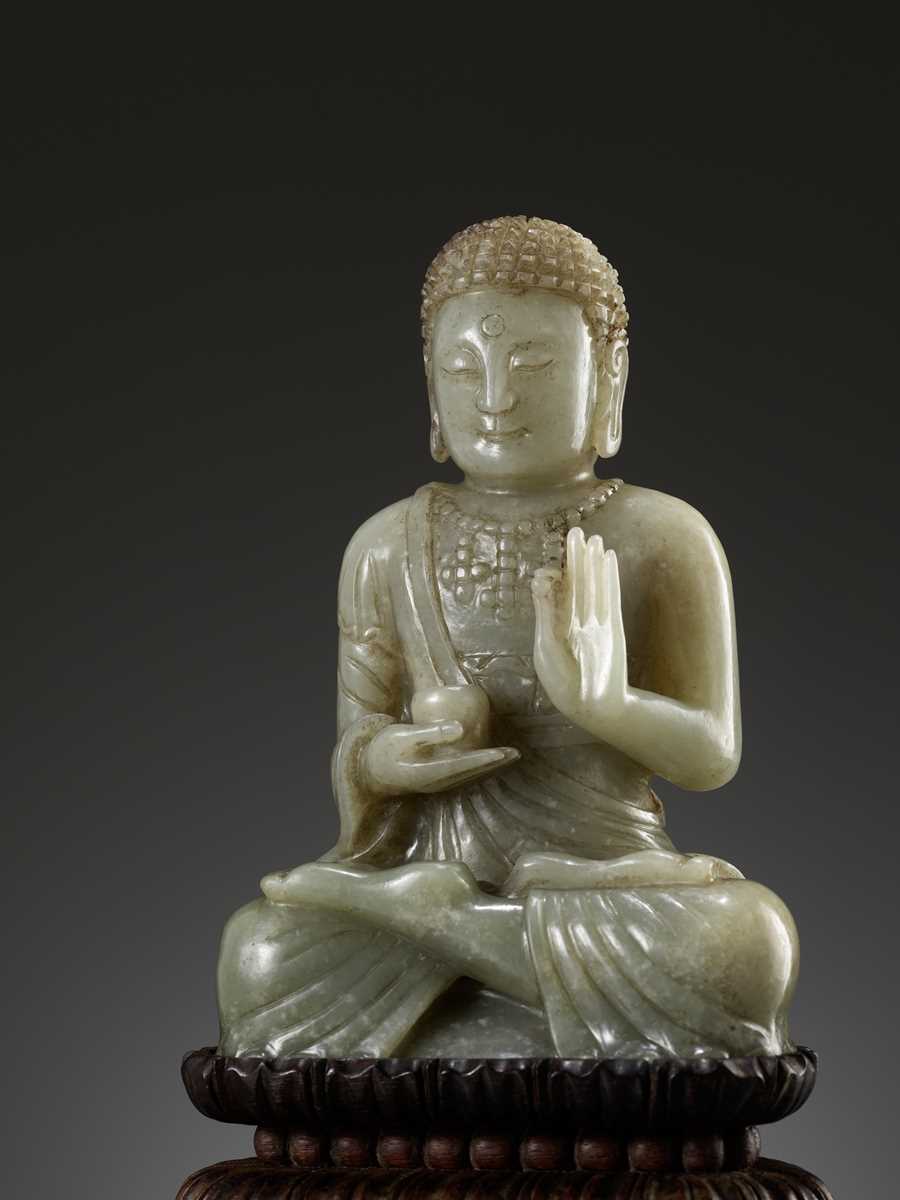9th Mar, 2023 13:00
TWO-DAY AUCTION - Fine Chinese Art / 中國藝術集珍 / Buddhism & Hinduism
40
A CELADON JADE FIGURE OF BUDDHA, 17TH-18TH CENTURY
十七至十八世紀青玉佛
Sold for €10,400
including Buyer's Premium
China. Finely carved, seated in dhyanasana, holding an offering bowl in his lowered right hand, his raised left held in abhaya mudra, wearing heavily pleated robes draped over his right shoulder and opening at the chest to reveal a beaded necklace. His serene face with heavy-lidded eyes centered by a circular urna and slender lips forming a benevolent smile. The superbly polished stone is of a deep celadon tone with cloudy inclusions and russet veins. Note the high translucency of the jade, particularly striking in the left hand.
Provenance: The trade in Paris, France.
Condition: Very good condition with minor old wear, few minuscule nicks, remnants of ink, the stone with natural fissures, some of which may have developed into small hairline cracks over time.
Weight: 1,180 g (excl. stand)
Dimensions: 16.5 cm (excl. stand) and 19.5 cm (incl. stand)
With a finely carved and fitted zitan double lotus stand, dating from the same period. (2)
Buddhism flourished during the Qing dynasty, and was encouraged by the devotion of the Kangxi, Yongzheng, and Qianlong emperors. Buddhist artifacts were consequently produced in significant numbers for the imperial court, particularly as ceremonial gifts, such as for the birthdays of members of the court. The popularity of the present form of Buddha carved in jade is apparent from a number of examples of the highest quality surviving in the Imperial collections, most notably in the Palace Museum, Beijing.
Expert’s note: The present jade shows superficial remnants of ink, which we have left in place to some extent, despite the fact they are rather easy to remove, as they indicate appreciation by a previous collector, perhaps a scholar or artist who often had ink-stained fingers as they handled this Buddha.
Literature comparison:
See for example a fine celadon jade Buddha, illustrated in Compendium of Collections in the Palace Museum, Jade 8: Qing Dynasty, Beijing, 2011, no. 234, and other Buddhas illustrated ibidem, nos. 236-238. The Imperial association for such jade Buddhas is further evidenced by a related white jade Buddha from the Prince Kung Collection, illustrated in the catalog produced by American Art Galleries, The Remarkable Collection of the Imperial Prince Kung of China, New York, 1913, no. 71. A celadon jade figure of Buddha Shakyamuni, holding a small stupa, is illustrated in Treasures from Snow Mountains, Gems of Tibetan Cultural Relics, Shanghai Museum, 2001, no. 37.
Auction result comparison:
Type: Closely related
Auction: Christie’s Hong Kong, 28 May 2021, lot 2718
Price: HKD 1,375,000 or approx. EUR 168,000 converted and adjusted for inflation at the time of writing
Description: A pale greenish-white jade seated figure of Buddha, Qing dynasty, 18th century
Expert remark: Note the similar size (17.2 cm)
Auction result comparison:
Type: Closely related
Auction: Christie’s London, 9 November 2012, lot 1281
Price: GBP 70,850 or approx. EUR 105,000 converted and adjusted for inflation at the time of writing
Description: A large celadon jade Buddha mounted on a gilt bronze stand, 18th century
Expert remark: Note the larger size (24.2 cm incl. stand)
Auction result comparison:
Type: Closely related
Auction: Sotheby’s London, 7 November 2012, lot 231
Price: GBP 70,850 or approx. EUR 105,000 converted and adjusted for inflation at the time of writing
Description: A celadon jade figure of Buddha, Qing dynasty, 18th century
Expert remark: Note the similar size (15.9 cm)
十七至十八世紀青玉佛
中國。釋迦牟尼佛全跏趺坐,雙臂自然下垂,左手於胸前施無畏印,右手腹前托一小缽;螺髮規整,雙耳垂肩,眉彎與鼻脛相連,慈顏垂視,嘴角略帶微笑,神態怡然,法相莊嚴;身軀端正,著袒左肩式袈裟,袒露前胸。衣褶自然流暢,刻工栩栩如生。青玉有白色絮狀紋理。
來源:法國巴黎古玩交易。
品相:狀況極好,有輕微磨損與微小的劃痕,墨水殘留,帶有天然裂縫的石料,隨著時間的推移,其中一些可能已經發展成細小的裂紋。
重量:1,180 克 (不含底座)
尺寸:16.5 釐米 (不含底座) ,19.5 釐米 (含底座)
紫檀雕刻雙層蓮座,來自同一時期。 (2)
佛教在清代盛行,康熙、雍正、乾隆皇帝的虔誠使佛教得到了推廣。因此,御用工坊生產了大量的佛教造器,特別是作為禮物,例如宮廷成員的生日禮物。從北京故宮博物院皇家收藏中現存的一些最高品質的例子可以看出,這類玉雕佛像很受歡迎。
專家注釋:本玉器表面有墨跡,我們在一定程度上保留了墨跡,儘管它們很容易去除,因為它們表明前一位收藏家的欣賞,可能是手指經常沾墨的文人或藝術家撫摸這尊佛陀時留下的。
文獻比較:
一件精美的玉雕佛,見《故宮博物院藏品大系‧玉器8‧清代》,北京,2011年,編號234;一件玉佛見上本書,編號236-238。一件相近的白玉佛進一步證明了這種玉佛為御用工坊製作,收藏於Prince Kung Collection,見American Art Galleries,《The Remarkable Collection of the Imperial Prince Kung of China》,紐約,1913年,編號71。一件青白玉雕釋迦牟尼,拿著小佛塔,見《Treasures from Snow Mountains,Gems of Tibetan Cultural Relics》,上海博物館,2001年,編號37。
拍賣結果比較:
形制:非常相近
拍賣:香港佳士得,2021年5月28日,lot 2718
價格:HKD 1,375,000(相當於今日EUR 168,000)
描述:清十八世紀青白玉佛坐像
專家評論:請注意相似的尺寸(17.2 厘米) 。
拍賣結果比較:
形制:非常相近
拍賣:倫敦佳士得,2012年11月9日,lot 1281
價格:GBP 70,850(相當於今日EUR 105,000)
描述:青玉雕釋迦摩尼坐像
專家評論:請注意尺寸較大(24.2 厘米含底座)。
拍賣結果比較:
形制:非常相近
拍賣:倫敦蘇富比,2012年11月7日,lot 231
價格:GBP 70,850(相當於今日EUR 105,000)
描述:清十八世紀青白玉佛坐像
專家評論:請注意相似的尺寸(15.9 厘米)。
China. Finely carved, seated in dhyanasana, holding an offering bowl in his lowered right hand, his raised left held in abhaya mudra, wearing heavily pleated robes draped over his right shoulder and opening at the chest to reveal a beaded necklace. His serene face with heavy-lidded eyes centered by a circular urna and slender lips forming a benevolent smile. The superbly polished stone is of a deep celadon tone with cloudy inclusions and russet veins. Note the high translucency of the jade, particularly striking in the left hand.
Provenance: The trade in Paris, France.
Condition: Very good condition with minor old wear, few minuscule nicks, remnants of ink, the stone with natural fissures, some of which may have developed into small hairline cracks over time.
Weight: 1,180 g (excl. stand)
Dimensions: 16.5 cm (excl. stand) and 19.5 cm (incl. stand)
With a finely carved and fitted zitan double lotus stand, dating from the same period. (2)
Buddhism flourished during the Qing dynasty, and was encouraged by the devotion of the Kangxi, Yongzheng, and Qianlong emperors. Buddhist artifacts were consequently produced in significant numbers for the imperial court, particularly as ceremonial gifts, such as for the birthdays of members of the court. The popularity of the present form of Buddha carved in jade is apparent from a number of examples of the highest quality surviving in the Imperial collections, most notably in the Palace Museum, Beijing.
Expert’s note: The present jade shows superficial remnants of ink, which we have left in place to some extent, despite the fact they are rather easy to remove, as they indicate appreciation by a previous collector, perhaps a scholar or artist who often had ink-stained fingers as they handled this Buddha.
Literature comparison:
See for example a fine celadon jade Buddha, illustrated in Compendium of Collections in the Palace Museum, Jade 8: Qing Dynasty, Beijing, 2011, no. 234, and other Buddhas illustrated ibidem, nos. 236-238. The Imperial association for such jade Buddhas is further evidenced by a related white jade Buddha from the Prince Kung Collection, illustrated in the catalog produced by American Art Galleries, The Remarkable Collection of the Imperial Prince Kung of China, New York, 1913, no. 71. A celadon jade figure of Buddha Shakyamuni, holding a small stupa, is illustrated in Treasures from Snow Mountains, Gems of Tibetan Cultural Relics, Shanghai Museum, 2001, no. 37.
Auction result comparison:
Type: Closely related
Auction: Christie’s Hong Kong, 28 May 2021, lot 2718
Price: HKD 1,375,000 or approx. EUR 168,000 converted and adjusted for inflation at the time of writing
Description: A pale greenish-white jade seated figure of Buddha, Qing dynasty, 18th century
Expert remark: Note the similar size (17.2 cm)
Auction result comparison:
Type: Closely related
Auction: Christie’s London, 9 November 2012, lot 1281
Price: GBP 70,850 or approx. EUR 105,000 converted and adjusted for inflation at the time of writing
Description: A large celadon jade Buddha mounted on a gilt bronze stand, 18th century
Expert remark: Note the larger size (24.2 cm incl. stand)
Auction result comparison:
Type: Closely related
Auction: Sotheby’s London, 7 November 2012, lot 231
Price: GBP 70,850 or approx. EUR 105,000 converted and adjusted for inflation at the time of writing
Description: A celadon jade figure of Buddha, Qing dynasty, 18th century
Expert remark: Note the similar size (15.9 cm)
十七至十八世紀青玉佛
中國。釋迦牟尼佛全跏趺坐,雙臂自然下垂,左手於胸前施無畏印,右手腹前托一小缽;螺髮規整,雙耳垂肩,眉彎與鼻脛相連,慈顏垂視,嘴角略帶微笑,神態怡然,法相莊嚴;身軀端正,著袒左肩式袈裟,袒露前胸。衣褶自然流暢,刻工栩栩如生。青玉有白色絮狀紋理。
來源:法國巴黎古玩交易。
品相:狀況極好,有輕微磨損與微小的劃痕,墨水殘留,帶有天然裂縫的石料,隨著時間的推移,其中一些可能已經發展成細小的裂紋。
重量:1,180 克 (不含底座)
尺寸:16.5 釐米 (不含底座) ,19.5 釐米 (含底座)
紫檀雕刻雙層蓮座,來自同一時期。 (2)
佛教在清代盛行,康熙、雍正、乾隆皇帝的虔誠使佛教得到了推廣。因此,御用工坊生產了大量的佛教造器,特別是作為禮物,例如宮廷成員的生日禮物。從北京故宮博物院皇家收藏中現存的一些最高品質的例子可以看出,這類玉雕佛像很受歡迎。
專家注釋:本玉器表面有墨跡,我們在一定程度上保留了墨跡,儘管它們很容易去除,因為它們表明前一位收藏家的欣賞,可能是手指經常沾墨的文人或藝術家撫摸這尊佛陀時留下的。
文獻比較:
一件精美的玉雕佛,見《故宮博物院藏品大系‧玉器8‧清代》,北京,2011年,編號234;一件玉佛見上本書,編號236-238。一件相近的白玉佛進一步證明了這種玉佛為御用工坊製作,收藏於Prince Kung Collection,見American Art Galleries,《The Remarkable Collection of the Imperial Prince Kung of China》,紐約,1913年,編號71。一件青白玉雕釋迦牟尼,拿著小佛塔,見《Treasures from Snow Mountains,Gems of Tibetan Cultural Relics》,上海博物館,2001年,編號37。
拍賣結果比較:
形制:非常相近
拍賣:香港佳士得,2021年5月28日,lot 2718
價格:HKD 1,375,000(相當於今日EUR 168,000)
描述:清十八世紀青白玉佛坐像
專家評論:請注意相似的尺寸(17.2 厘米) 。
拍賣結果比較:
形制:非常相近
拍賣:倫敦佳士得,2012年11月9日,lot 1281
價格:GBP 70,850(相當於今日EUR 105,000)
描述:青玉雕釋迦摩尼坐像
專家評論:請注意尺寸較大(24.2 厘米含底座)。
拍賣結果比較:
形制:非常相近
拍賣:倫敦蘇富比,2012年11月7日,lot 231
價格:GBP 70,850(相當於今日EUR 105,000)
描述:清十八世紀青白玉佛坐像
專家評論:請注意相似的尺寸(15.9 厘米)。
Zacke Live Online Bidding
Our online bidding platform makes it easier than ever to bid in our auctions! When you bid through our website, you can take advantage of our premium buyer's terms without incurring any additional online bidding surcharges.
To bid live online, you'll need to create an online account. Once your account is created and your identity is verified, you can register to bid in an auction up to 12 hours before the auction begins.
Intended Spend and Bid Limits
When you register to bid in an online auction, you will need to share your intended maximum spending budget for the auction. We will then review your intended spend and set a bid limit for you. Once you have pre-registered for a live online auction, you can see your intended spend and bid limit by going to 'Account Settings' and clicking on 'Live Bidding Registrations'.
Your bid limit will be the maximum amount you can bid during the auction. Your bid limit is for the hammer price and is not affected by the buyer’s premium and VAT. For example, if you have a bid limit of €1,000 and place two winning bids for €300 and €200, then you will only be able to bid €500 for the rest of the auction. If you try to place a bid that is higher than €500, you will not be able to do so.
Online Absentee and Telephone Bids
You can now leave absentee and telephone bids on our website!
Absentee Bidding
Once you've created an account and your identity is verified, you can leave your absentee bid directly on the lot page. We will contact you when your bids have been confirmed.
Telephone Bidding
Once you've created an account and your identity is verified, you can leave telephone bids online. We will contact you when your bids have been confirmed.
Classic Absentee and Telephone Bidding Form
You can still submit absentee and telephone bids by email or fax if you prefer. Simply fill out the Absentee Bidding/Telephone bidding form and return it to us by email at office@zacke.at or by fax at +43 (1) 532 04 52 20. You can download the PDF from our Upcoming Auctions page.
How-To Guides
How to Create Your Personal Zacke Account
How to Register to Bid on Zacke Live
How to Leave Absentee Bids Online
How to Leave Telephone Bids Online
中文版本的操作指南
创建新账号
注册Zacke Live在线直播竞拍(免平台费)
缺席投标和电话投标
Third-Party Bidding
We partner with best-in-class third-party partners to make it easy for you to bid online in the channel of your choice. Please note that if you bid with one of our third-party online partners, then there will be a live bidding surcharge on top of your final purchase price. You can find all of our fees here. Here's a full list of our third-party partners:
- 51 Bid Live
- EpaiLive
- ArtFoxLive
- Invaluable
- LiveAuctioneers
- the-saleroom
- lot-tissimo
- Drouot
Please note that we place different auctions on different platforms. For example, in general, we only place Chinese art auctions on 51 Bid Live.
Bidding in Person
You must register to bid in person and will be assigned a paddle at the auction. Please contact us at office@zacke.at or +43 (1) 532 04 52 for the latest local health and safety guidelines.
